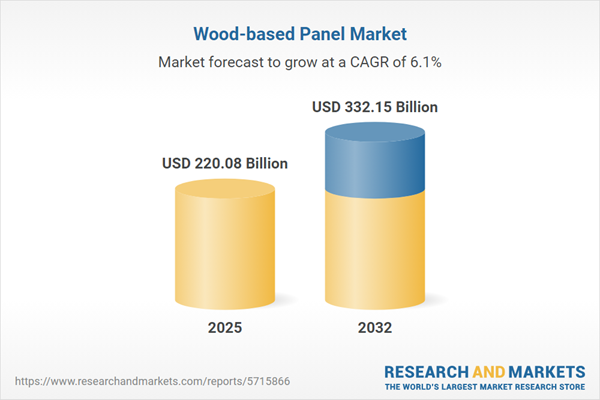Speak directly to the analyst to clarify any post sales queries you may have.
The wood-based panel market is rapidly evolving, shaped by rising regulatory demands, sustainability imperatives, and rapid digitalization. Senior decision-makers are navigating an environment where adaptability and ongoing innovation are essential for strong, future-ready performance.
Market Snapshot: Wood-Based Panel Market Growth Overview
The global wood-based panel market reached USD 207.48 billion in 2024 and is expected to grow to USD 220.08 billion in 2025, advancing at a projected CAGR of 6.05% through 2032. Regulatory changes and advancements in production technologies are driving lasting progress and building greater resilience within the sector. Companies are responding to shifts in environmental expectations and the need for agile supply chain management to maintain market competitiveness. As digital transformation gains momentum, applications for wood-based panels are broadening across commercial, industrial, and construction segments, expanding revenue possibilities while supporting risk-informed growth throughout the value chain.
Scope & Segmentation of the Wood-Based Panel Market
This analysis examines how leading enterprises are leveraging advanced segmentation and digital adoption to reshape the wood-based panel market landscape. Firms are prioritizing investment in workflow innovations and versatile materials to better align with regulations and achieve market differentiation. The scope covers essential domains that influence strategic decision-making:
- Product Type: Hardboard, medium density fiberboard, oriented strand board, particleboard, and plywood—offering versatility for structural, decorative, and specialized roles across construction, interiors, and packaging.
- Resin Type: Melamine-based, phenolic, and urea formaldehyde adhesives—each playing a part in emissions management, cost efficiency, and long-term durability to meet eco-conscious standards.
- Application: Construction, flooring, furniture, and packaging segments—reflecting the varied needs of design, logistics, and building activities in global settings.
- Thickness: Up to 9 mm, 9–12 mm, and above 12 mm—enabling solutions across a wide spectrum of structural and design requirements.
- Wood Type: Hardwood and softwood—facilitating compliance with sustainability targets and construction regulations across different regions.
- End User: Enterprises in commercial, industrial, and residential segments—each with unique procurement and operational requirements, shaping sourcing strategies and production volumes.
- Geographies: Americas, Europe, Middle East & Africa, and Asia-Pacific—critical for understanding local regulations, raw material sourcing, and buyer preferences.
As sustainability protocols and digital transformation become central to industry best practices, the quality of segmentation drives organizations’ ability to tailor approaches and leverage recycling and eco-friendly innovations for improved market positioning.
Key Takeaways for Senior Decision-Makers
- Accelerating use of bio-based and next-generation adhesives enables companies to address evolving sustainability obligations and enhance perceived environmental performance.
- Building code tightening and new compliance demands are elevating interest in eco-labeled panels, influencing construction standards and project requirements globally.
- Digital technologies like process automation, predictive maintenance, and advanced quality controls support operational efficiency and scalable production, strengthening manufacturing and supply chain reliability.
- Collaboration with sustainable forestry and design associations aids in developing tailored portfolios for both architectural and interior uses, enhancing differentiation.
- Incorporating recycled content and advancing closed-loop production models help meet international regulatory expectations as well as foster innovative product development and refined brand positioning.
- Diversified sourcing and flexible pricing strategies build resilience against disruptive trade or policy shifts, particularly in response to changing tariff environments and supply uncertainties.
Tariff Impact on Market Dynamics
Recent tariff policy shifts, especially in the United States, are compelling companies to update their procurement models and expand supplier bases, including new partnerships in Latin America and Southeast Asia. This transition is transforming logistics and transportation systems, with organizations strengthening their supply chains for agility and cost control, while also improving operational effectiveness in an increasingly complex global marketplace.
Methodology & Data Sources
Findings are based on secondary research from academic, industrial, and proprietary sources, supplemented by direct interviews with sector executives, technical experts, and procurement leaders. Triangulation and peer review validate all findings, ensuring confidence in the report’s insights.
Why This Report Matters
- Provides actionable insights to help business leaders identify emerging opportunities, assess current market positioning, and optimize strategy in the wood-based panel sector.
- Offers detailed segmentation and performance benchmarks highlighting digital transformation, agile supply chain adoption, and sustainability progress.
- Equips organizations to manage regulatory change and quickly respond to shifts in demand across key segments, including construction, manufacturing, and residential markets.
Conclusion
The wood-based panel market is at a significant turning point, shaped by technology, sustainability goals, and evolving sourcing strategies. This report delivers clear, actionable intelligence to empower senior leaders’ strategic decision-making and growth planning.
Additional Product Information:
- Purchase of this report includes 1 year online access with quarterly updates.
- This report can be updated on request. Please contact our Customer Experience team using the Ask a Question widget on our website.
Table of Contents
3. Executive Summary
4. Market Overview
7. Cumulative Impact of Artificial Intelligence 2025
List of Figures
Samples

LOADING...
Companies Mentioned
The key companies profiled in this Wood-based Panel market report include:- Kronospan Holding Limited
- Kastamonu Entegre Ağaç Sanayi ve Ticaret A.Ş.
- EGGER Holzwerkstoffe GmbH
- Sonae Arauco SGPS, S.A.
- Unilin BV
- West Fraser Timber Co. Ltd.
- Celulosa Arauco y Constitución S.A.
- Duratex S.A.
- Pfleiderer Group Sàrl
- Masisa S.A.
Table Information
| Report Attribute | Details |
|---|---|
| No. of Pages | 180 |
| Published | October 2025 |
| Forecast Period | 2025 - 2032 |
| Estimated Market Value ( USD | $ 220.08 Billion |
| Forecasted Market Value ( USD | $ 332.15 Billion |
| Compound Annual Growth Rate | 6.0% |
| Regions Covered | Global |
| No. of Companies Mentioned | 11 |









